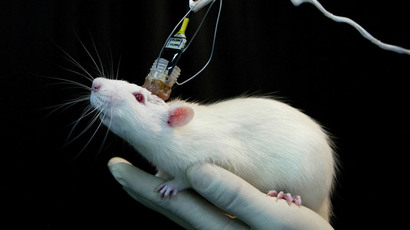Bioengineers build 3D tissue mimicking brain structure

A group of US scientists have managed to create a three-dimensional brain-like tissue featuring structural similarities to rat brain. Researchers hope that the new tissue could be used in the development of new treatments for brain dysfunctions.
The brain-like tissue was bioengineered at the Tissue Engineering Resource Center at Tufts University in Boston. Professor David Kaplan led the research efforts to develop the tissue which can be kept alive in the laboratory for more than two months.
“This work is an exceptional feat,” said Rosemarie Hunziker, program director of Tissue Engineering at the US National Institute of Biomedical Imaging and Bioengineering (NIBIB) which funded the project. “It combines a deep understand of brain physiology with a large and growing suite of bioengineering tools to create an environment that is both necessary and sufficient to mimic brain function.”
Earlier methods of recreating brain tissues in petri dishes or 3D gel environments failed to replicate the segregated structure of a real brain, where grey and white matter form separate regions.
As simply allowing neurons to randomly grow in three dimensions was not good enough, researches created a novel composite structure which consisted of two biomaterials with different physical properties.
A spongy scaffold made out of silk protein was cut into a donut shape and served as the form in which rat brain neurons built functional networks of the grey matter. The middle of the donut was filled with collagen-based gel which encouraged axons grow through it forming a white matter region.

“The tissue maintained viability for at least nine weeks — significantly longer than cultures made of collagen or hydrogel alone — and also offered structural support for network connectivity that is crucial for brain activity,” said the paper's first author, Min D. Tang-Schomer, at Tufts.
The researchers then studied the health and function of the neurons growing in their new 3D brain-like tissue over a period of several weeks and conducted several tests to demonstrate its potential.
In one test, researchers simulated a traumatic brain injury by dropping a weight on the tissue and recording changes in neurons’ activity almost in real time, as compared to having to dissect and prepare real rodent brain for an experiment. During another test researchers tracked tissue response to a drug, according to the study published in the Proceedings of the National Academy of Sciences.
The team did not reconstruct a whole-brain network, but rather used a modular design to replicate fundamental features of the brain's tissue-level physiological functions. However, they demonstrated the possibility of creating more complex structures, such as a set of concentric rings simulating the layered structure of the neocortex.
“The stiffness of the silk biomaterial could be tuned to accommodate the cortical neurons and the different types of gels, maintaining both stability in culture and brain-like tissue elasticity,” Min D. Tang-Schomer said.
“This model provides a unique opportunity for mapping out real-time neurophysiological events and function studies in the laboratory, monitoring that is prohibitive with humans or animals,” said study co-author Philip Haydon, professor of neuroscience at Tufts University School of Medicine.
Kaplan says that the new model can be used to study brain structure-function, drug screening, disease formation and treatments, and the effects of nutrition and toxicants. “This is the first step,” he said.














